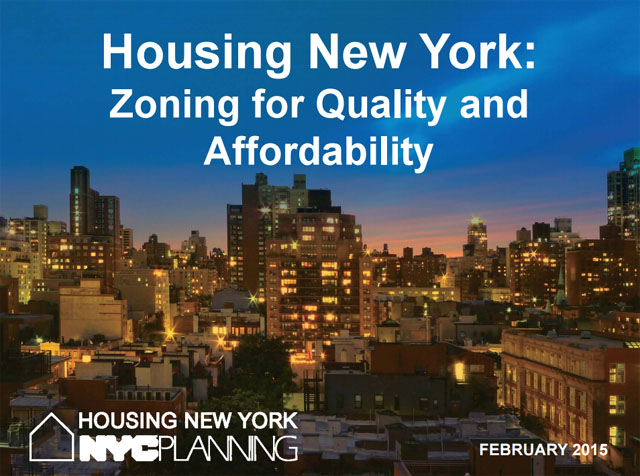March 25, 2015
Statement of the Historic Districts Council
City Planning Commission
Zoning for Quality & Affordability
The Historic Districts Council is the citywide advocate for New York’s historic neighborhoods. We represent over 500 neighborhood-based group dedicated to preserving the physical character of their communities. Many of our constituents have spent years working with property owners, Community Boards, City Planning and elected officials to enact contextual zones in order to better protect the character of their neighborhoods and encourage appropriate new development which enhances where they call home. It is on their behalf that we address our very strong concerns about this proposed citywide zoning text amendment.
Frankly put, this amendment as it is proposed, takes the context out of contextual zoning. It arbitrarily raises height limits and diminishes yard requirements across the board according to a mathematical nicety, not based in the actual built fabric of our city’s neighborhoods. Contextual zones came to fruition after years of effort by community-driven, carefully examined, neighborhood-specific studies. New York thrives because of the diversity of its neighborhoods, yet this proposal’s approach will deal with each neighborhood as the same, with a one-size-fits-all approach. HDC requests that the environmental review include an actual study of the median street wall and set-back height and yard coverage of all the potential areas affected. A calculation of potential growth based on a model is not the same as actual development, especially when one considers the diversity of New York’s built environment. This amendment will affect a lot–approximately 10.4% of properties, according to our calculations. This potential impact on these properties must be studied carefully before being executed.
This is a plan without prescription. It should be prescribed that only units constructed for affordable or senior housing receive height bonuses, which would incentivize construction of the housing stock that is the genesis of this proposal and that the City so desperately needs. At this moment, the proposal incentivizes all development, without any guarantee that it will actually house New Yorkers who are rent-burdened. In fact, a point could be made that this might incentivize demolition of existing housing in order to replace it with new development utilizing the proposed as-of-right height limits. This could increase displacement while only adding more market-rate housing to the pool. Bigger buildings do not equal lower rents, if that were the case, West 57th Street would be Manhattan’s newest neighborhood for the middle class.
There is also no explanation of how building higher will mandate construction of quality buildings like the examples in the proposal. Interestingly, the new construction that City Planning aspires to create is found in historic districts in all five boroughs, as these buildings are designed from a human perspective and new development is carefully scrutinized to meet its context. It is outside of the city’s historic and contextual districts where true banality dwells and quality design is an elusive sight.
Further, HDC is concerned that this proposal has not taken into consideration the undue burden on contextually zoned properties that fall under the Landmarks Preservation Commission’s (LPC) purview. LPC is hard-pressed regulating property for “appropriate” development in instances when the as-of-right base zoning allows substantially more potential building mass than what is actually built – relief of this pressure is one reason why contextual rezonings are often paired with historic district designations. By raising the height limits and lessening the yard requirements to landmark properties, the development expectations are increased and the LPC is given the unenviable task of having to resist policy enacted by a sister city agency. This could result in hardship claims, legal challenges and undue pressures on the LPC to act outside of its own mission.
Finally, we ask that special attention be paid in the environmental review to the effects the proposed changes might have to designated landmark properties, as well as properties determined eligible for or included on the New York State or National Register of Historic Places (as is required by municipal and state law regardless). With these concerns in mind, we feel that this proposal is myopic, hasty, and created without New Yorkers or their neighborhoods in mind.
To view the proposal click here




